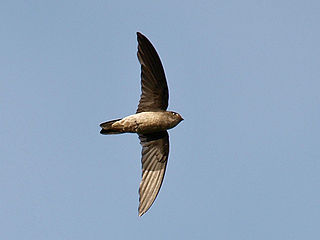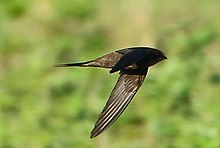
The common swift is a medium-sized bird, superficially similar to the barn swallow or house martin but somewhat larger, though not stemming from those passerine species, being in the order Apodiformes. The resemblances between the groups are due to convergent evolution, reflecting similar contextual development. The swifts' nearest relatives are the New World hummingbirds and the Southeast Asian treeswifts.

The ferruginous duck, also known as ferruginous pochard, common white-eye or white-eyed pochard, is a medium-sized diving duck from Eurosiberia. The scientific name is derived from the Ancient Greek word, αἴθυιᾰ, an unknown seabird mentioned by authors including Hesychius and Aristotle, and the Russian word, нырок, the Russian word for pochard, which occurs in the bird's Russian common name.

The little swift, is a small species of swift found in Africa and southwestern Asia, and are vagrants and local breeders in southern Europe. They are found both in urban areas and at rocky cliffs where they build nests in a way typical of all members of the order Apodiformes. The genus name Apus is Latin for a swift, thought by the ancients to be a type of swallow without feet. The Latin specific affinis means similar to or related to, but in this case the species that the little swift supposedly resembles is not clear from the description. A population formerly considered to be an eastern subspecies of little swift is now separated as a distinct species, the house swift.

The pallid swift is a swift. Swifts have very short legs which they use only for clinging to vertical surfaces. The genus name Apus is Latin for a swift, thought by the ancients to be a type of swallow with no feet, and pallidus is Latin for "pale". They never settle voluntarily on the ground. Swifts spend most of their lives in the air, living on the insects they catch in their beaks. They drink on the wing.

Swiftlets are birds from the four genera Aerodramus, Collocalia, Hydrochous and Schoutedenapus, which form the tribe Collocaliini within the swift family Apodidae. The group contains around thirty species mostly confined to southern Asia, south Pacific islands, and northeastern Australia, all within the tropical and subtropical regions. They are in many respects typical members of the Apodidae, having narrow wings for fast flight, with a wide gape and small reduced beak surrounded by bristles for catching insects in flight. What distinguishes many but not all species from other swifts and indeed almost all other birds is their ability to use a simple but effective form of echolocation to navigate in total darkness through the chasms and shafts of the caves where they roost at night and breed.

The African palm swift is a small swift. It is very similar to the Asian palm swift, Cypsiurus balasiensis, and was formerly considered to be the same species. The Malagasy palm swift was also recently split from this species. This is a common species with a very wide distribution which faces no obvious threats and may be increasing in numbers as a result of the cultivation of the exotic Washington palm, so the International Union for Conservation of Nature has rated its conservation status as being of "least concern".

The Asian palm swift is a small swift. It is very similar to the African palm swift, Cypsiurus parvus, and was formerly considered to be the same species.

The white-rumped swift is a species of swift. Although this small bird is superficially similar to a house martin, it is not closely related to that passerine species. The resemblances between the swallows and swifts are due to convergent evolution reflecting similar life styles.

The desert sparrow is a species of bird in the sparrow family Passeridae, found in the Sahara Desert of northern Africa. A similar bird, Zarudny's sparrow, is found in Central Asia and was historically recognised as a subspecies of the desert sparrow, but varies in a number of ways and is now recognised as a separate species by BirdLife International, the IOC World Bird List, and the Handbook of the Birds of the World Alive.

The oriole finch is a small passerine bird in the finch family. It is found in Africa and is native to Burundi, Cameroon, Democratic Republic of the Congo, Equatorial Guinea, Kenya, Malawi, Nigeria, Rwanda, South Sudan, Tanzania and Uganda. It lives in subtropical or tropical moist evergreen montane forests.
The purple needletail, or hagibas in Tagalog, is the largest swift found in the Old World. It is native to the Philippine archipelago and the Minahasa Peninsula (Sulawesi).

The African black swift, also known as the African swift or black swift, is a medium-sized bird in the swift family. It breeds in Africa discontinuously from Liberia, Cameroon, Zaire, Uganda and Kenya southwards to South Africa. The "black swifts" of Madagascar and the Comoros are either taken as two subspecies of the African black swift, or otherwise deemed a full species, the Malagasy black swift.

The black-and-white mannikin also black-and-white munia or red-backed mannikin, is a species of estrildid finch, widely occurring throughout the African tropical rainforest. It has an estimated global extent of occurrence of 4,200,000 km2. It is found in moist savanna and subtropical or tropical moist lowland forest habitat. The status of the species is evaluated as least concern. They are seedeaters, but are known to feed on algae.

The Nyanza swift is a species of swift in the family Apodidae. It is found in Eritrea, Ethiopia, Kenya, Somalia, South Sudan, Tanzania, and Uganda.
The mottled swift is a species of bird in the swift family, Apodidae. It is one of two species in the genus Tachymarptis together with the alpine swift. It occurs widely in eastern Africa and locally in western Africa. It is found in Angola, Burkina Faso, Burundi, Cameroon, Central African Republic, Chad, Democratic Republic of the Congo, Ivory Coast, Eritrea, Ethiopia, Gabon, Ghana, Guinea, Kenya, Malawi, Mali, Mozambique, Nigeria, Rwanda, Sierra Leone, Sudan, Tanzania, Togo, Uganda, Zambia, and Zimbabwe.
The Itombwe owl is a species of owl in the barn owl family, Tytonidae. It is restricted to a small area in the Albertine Rift montane forests.

The wildlife of Togo is composed of the flora and fauna of Togo, a country in West Africa. Despite its small size the country has a diversity of habitats; there are only remnants of the once more extensive rain forests in the south, there is Sudanian savanna in the north-western part of the country and larger areas of Guinean forest–savanna mosaic in the centre and north-east. The climate is tropical with distinct wet and dry seasons. There are estimated to be over 3000 species of vascular plants in the country, and 196 species of mammals and 676 species of birds have been recorded there.

The Malagasy palm swift is a small swift in the family Apodidae. It is very similar to the African palm swift, Cypsiurus parvus, with which it was formerly considered conspecific. It was split based on differences in vocalizations and plumage coloration.
Antoon Emeric Marcel De Roo was a Belgian ornithologist.























